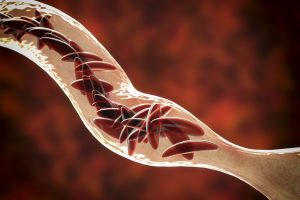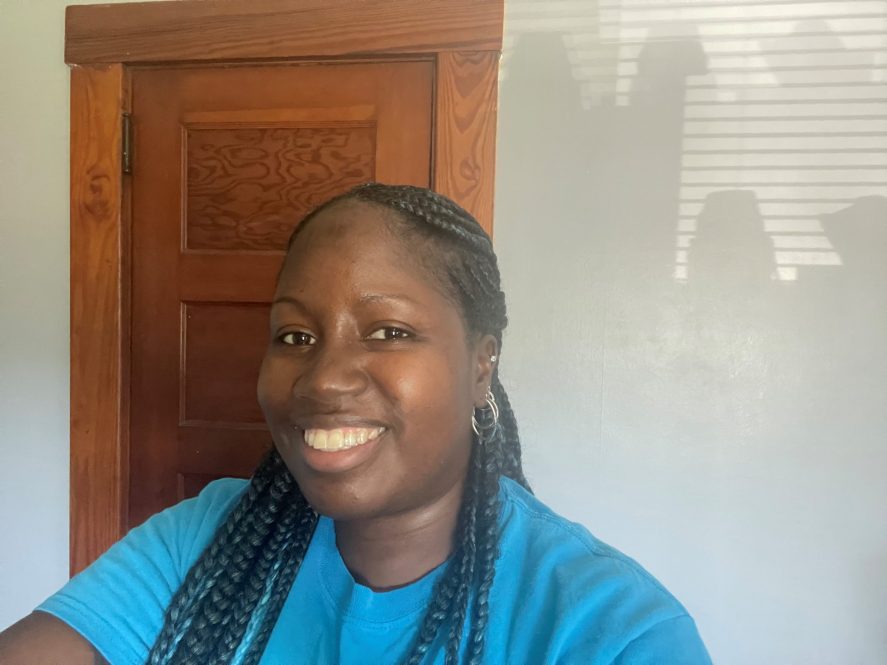World Sickle Cell Day is celebrated every June 19. But thanks to a promising, oral medication’s ongoing global clinical trial testing conducted by UConn School of Medicine, every day is now a celebration for the better for individuals born with sickle cell disease like Monica Aiken, 34, of Middletown, Conn.
Aiken has participated in the Phase 2a clinical trial and ongoing expanded open label extension (OLE) trial testing the safety and clinical benefits of the experimental sickle cell pill IMR-687. The program has advanced to the next clinical trial and patients take two tablets of IMR-687 once-a-day.

The drug’s latest clinical trial investigations are led by Aiken’s very own UConn Health physician Dr. Biree Andemariam, director of the New England Sickle Cell Institute and professor of medicine at UConn School of Medicine.
On June 11 Andemariam presented the drug’s latest positive clinical trial findings at the international European Hematology Association (EHA) Annual Congress hosted virtually June 9-17. The medication is showing promising results in sickle cell patients like Aiken with the once-a-day oral regimen helping them to better manage their sickle cell disease daily, lower their pain, and improve their daily quality of life.
The 93 patient Phase 2a clinical trial showed IMR-687 was well tolerated and decreased painful blood vessel blockages known as vaso-occlusive crises (VOCs) in adults with sickle cell versus placebo. Plus, the interim results of the expanded ongoing OLE longer-term, four-year study of IMR-687 in 24 adults with sickle cell showed it continues to be well-tolerated and the VOC benefits are maintained.
“I started taking the once-a-day pills not knowing at first if it was a real drug or placebo pill. But now I know I have been on it ever since 2018,” says Aiken. “It gives me more fetal hemoglobin and helps lessen my pain crises. I continue to take the pills still once-a-day. I am able to work more, and do more things.”
Aiken shares her personal recommendation to others struggling daily with sickle cell disease, about the new drug and entering the clinical trial if the chance presents.
“Go for it! I took the risk and it’s going well! It’s definitely great,” she says. “Dr. Andemariam and her ongoing research studies have changed my life.”
Aiken was first diagnosed as an infant with sickle cell disease. “My parents found out when I was just 5 months old after I had severe swelling in my fingers.”
Both of Aiken’s parents turned out to be carriers of the genetic sickle cell trait: “My Mom knew but my Dad didn’t until I was diagnosed.”
Sickle cell disease significantly impacted both Aiken’s childhood and early adulthood.

“I was home a lot from school especially when I had stomach pain caused by my sickle cell crises,” shares Aiken. “When I turned 18 my disease started to progress, especially during my senior year of high school, and I almost didn’t graduate as a result.”
But at age 21 Aiken thankfully met Andemariam at a sickle cell patient support group meeting. Ever since that chance encounter Aiken has been Andemariam’s patient. It has been more than a decade of advanced care.
“I love her,” says Aiken about Andemariam. As a result of Andemariam’s advanced sickle cell disease care not only has she had access to the latest, cutting-edge clinical trials available for her disease, she was able to stop frequent and time-consuming blood exchange transfusion treatments in 2015 thanks to UConn Health’s dedicated sickle cell Institute and its dedicated clinical care team’s close disease care outpatient management.
In the inherited sickle cell disease, a person’s red blood cells are abnormally sickle – or crescent – shaped, which can lead to painful VOCs. This most common sickle cell disease symptom leads patients to experience severe pain due to the development of these blockages in their smaller blood vessels when their abnormally shaped red blood cells cannot pass through smoothly and get stuck. These blockages can also lead to stroke and compromise the health of vital organs, reduce blood flow and cause dangerous blood infections.
Millions of people worldwide are affected by sickle cell disease including at least 100,000 Americans. Individuals with sickle cell have profound anemia, which means they don’t have a healthy level of oxygen-rich red blood cells circulating in their body.
However, the promising experimental drug IMR-687, a small molecule that inhibits phosphodiesterase-9 (PDE9), seeks to increase fetal hemoglobin levels (HbF) in sickle cell patients. Higher HbF is among the most important positive modifiers of sickle cell disease. Those with sickle cell disease who have higher HbF generally have less severe disease, less pain, and less organ damage. Red blood cells are filled with hemogloblin, the red blood cell protein that transports essential oxygen throughout the blood. In sickle cell disease, hemoglobin is abnormally produced, causing physical distortion of the red blood cells.
“The impact of IMR-687 on several pain-related parameters is an exciting development for the treatment of sickle cell disease,” said Andemariam, the clinical trial’s principal investigator. “These data include lower yearly pain crisis rates, fewer pain crisis-related hospitalizations, prolonged time to first pain crisis after starting treatment, and improvements in patient-reported pain severity score.”

Andemariam stresses: “Pain is the leading cause of emergency room visits and morbidity in sickle cell disease. It is not only excruciating to endure, but disrupts people’s lives and dreams. A reduction in pain is ultimately the most meaningful measure of clinical benefit to this patient community.”
“The VOC data in our 93-patient Phase 2a clinical trial point to a potential multimodal mechanism-of-action of IMR-687 in sickle cell disease that acts primarily on red blood cells and has the potential to act on white blood cells, adhesion mediators and other cell types. In addition, it is encouraging to see that patients in the OLE clinical trial are continuing to benefit from lower annualized vaso-occlusive crisis rates, extending the results seen in the six-month Phase 2a trial,” said Rahul Ballal, Ph.D., president and CEO of Imara, Inc. the drug’s maker. “These clinical outcome data have also prompted us to elevate annualized VOC rates to the key secondary endpoint in the ongoing Ardent Phase 2b clinical trial. We look forward to engaging the FDA in the coming months on these two datasets.”
“It is so inspiring and rewarding to see so many of our patients like Monica benefiting from our clinical trial work here at UConn Health,” says Sasia-Marie Jones, MPH, clinical research associate for the New England Sickle Cell Institute at UConn Health since 2013 who Andemariam credits as being instrumental to the clinical trial’s ongoing coordination and success. “It is truly a pleasure to be a part of advancements in treatment that may benefit sickle cell patients around the world someday. Seeing improvements in the quality of life our patients first-hand is an unexplainable feeling that keeps me going every day.”
Andemariam’s June 11 virtual presentation of the clinical trial’s latest findings at the EHA Congress is available on the Imara website.
This clinical trial study is currently open to sickle cell patients who are ages 18 to 65. For more information about study participation contact the study coordinator at: 860-541-0036.



